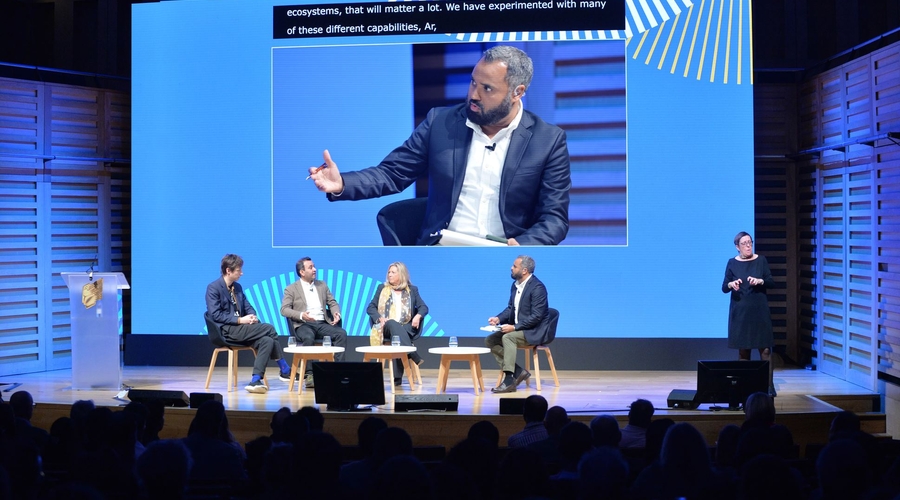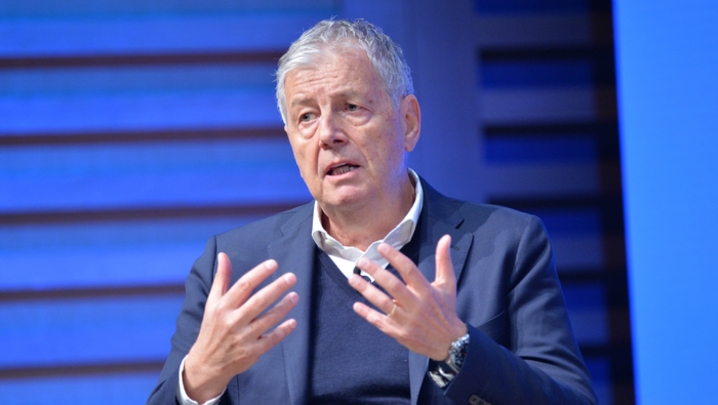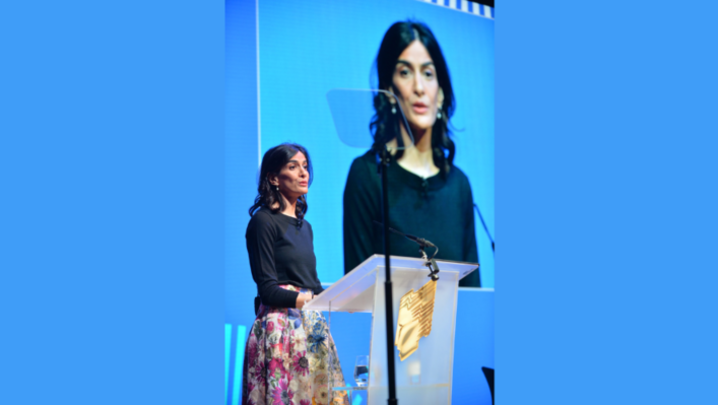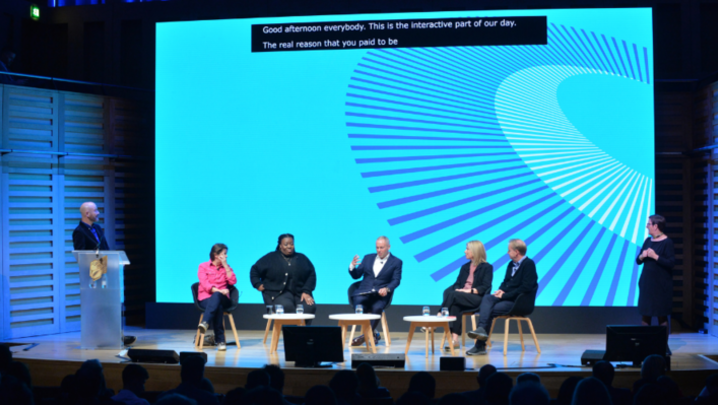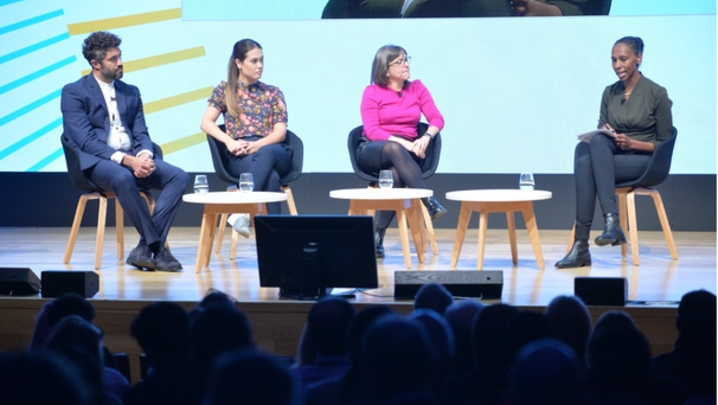Should broadcasters and producers be making their output ever-more immersive and interactive?
Explaining the “metaverse” to an audience of largely non-techie media folk was a tough ask, but the chair of this session, BBC News technology correspondent Marc Cieslak, came up with a novel approach.
Cieslak was on stage in person and also on the large screen behind him as a 3D avatar, “a trimmer, younger looking virtual version” of the correspondent. The avatar explained that the metaverse is essentially immersive technology: “If we think of the current internet as something that we look at; the metaverse is the next version of the net that we’re inside, experiencing [it] as a 3D avatar.”
Currently, the best examples of the metaverse come from games such as Fortnite.
The avatar continued: “The promise of the metaverse is twofold: it offers us increased immersion and engagement for audiences. Also, there are financial incentives for businesses: people will be – and already are – purchasing digital goods using real money. And there’s an enormous amount of data and insight to be gathered from users, customers or audiences.”
Back in the real word, Vicky Dobbs Beck, vice president of Lucasfilm, threw a spanner into the digital works: “We don’t use the term metaverse a lot because it means different things to different people.” She preferred the phrase “next-generation storytelling”, which signified “connected, cross-platform” content.
“In a nutshell,” said Jatin Aythora, director of BBC Research & Development, the metaverse is a “virtual world”.
Mundi Vondi, CEO of Berlin-based Klang Games, added: “Everything we’ve seen in the metaverse has already been done in games.”
Dobbs Beck identified three themes to the metaverse: connected storytelling; immersive content, using virtual reality (VR) and augmented reality (AR) “to allow people to step inside our stories”; and community, which she predicted would become ever-more important.
“Community is going to be an absolutely essential part of the future… it will be important for people to be able to experience some of these immersive story experiences together, and with people… they may have an affinity with but [whom] they don’t know.”
“We already build communities through our existing programming,” added Aythora, pointing to shows such as the BBC’s Springwatch. “There’s definitely an opportunity for us to reach more audiences through these virtual worlds, where we are able to create communities around interest. At the moment, the physical world doesn’t allow us to reach those mini-audiences globally, but the virtual world definitely opens up new opportunities.”
Vondi added: “Everything we’re building at Klang is about creating large communities…. One of the things we’ve been seeing in our research… is this crazy loneliness epidemic that we’re heading into. So, if people are not able to find new friends and socialise in the real world, this might be an opportunity for people to find each other and connect.”
The metaverse, said Dobbs Beck, has introduced “new storytelling canvases”, adding: “You have to be willing to experiment because it’s like being at the beginning of television or film, when we’re learning what is fun, compelling and has an emotional impact.”
The BBC, said Aythora, has long experimented with VR and AR, but is now starting to explore how it can bring live events into virtual worlds, “where we can not only improve interaction but also give an immersive experience”.
So much for the theory, but, asked Cieslak, is the metaverse “a goldmine opportunity or is this closer to a technological version of the emperor’s new clothes”?
Vondi said there was already a huge trade in virtual goods and that this would grow. Virtual goods are simply non-physical objects, bought for use in, say, online gaming; a broader definition would also include digital books or music. “It’s a continuous evolution – I don’t think it will come as a shock to anyone…. It seeps in slowly over time; more and more of your purchases will be virtual over time,” he predicted.
For the BBC, explained Aythora, the price of the AR and VR devices that enable people to enter virtual worlds is an obstacle. He said: “We certainly believe in universality and it’s important for us to be able to reach our audiences wherever they are. If these devices… become cheap and accessible, absolutely, yes. But at the moment, as we stand, it is not affordable for all to have those kinds of devices to experience these virtual worlds.”
Asked to offer advice to broadcasters about how best to embrace the metaverse, Dobbs Beck said: “You have to have courage and be willing to take some risks and experiment to understand how it fits into your bigger portfolio and creative strategy.”
Vondi added: “Really know what you are after. Be patient and expect it to take time and a lot of money to get there.”
Session Six, ‘A traveller’s guide to the metaverse’, featured: Jatin Aythora, director, BBC R&D; Vicki Dobbs Beck, VP of immersive content, Lucasfilm and ILMxLAB; and Mundi Vondi, CEO and co-founder, Klang Games. It was chaired by BBC News technology correspondent Marc Cieslak and produced by Nick Kwek. Report by Matthew Bell.
Queens of the Metaverse: virtual fashion meets real drag
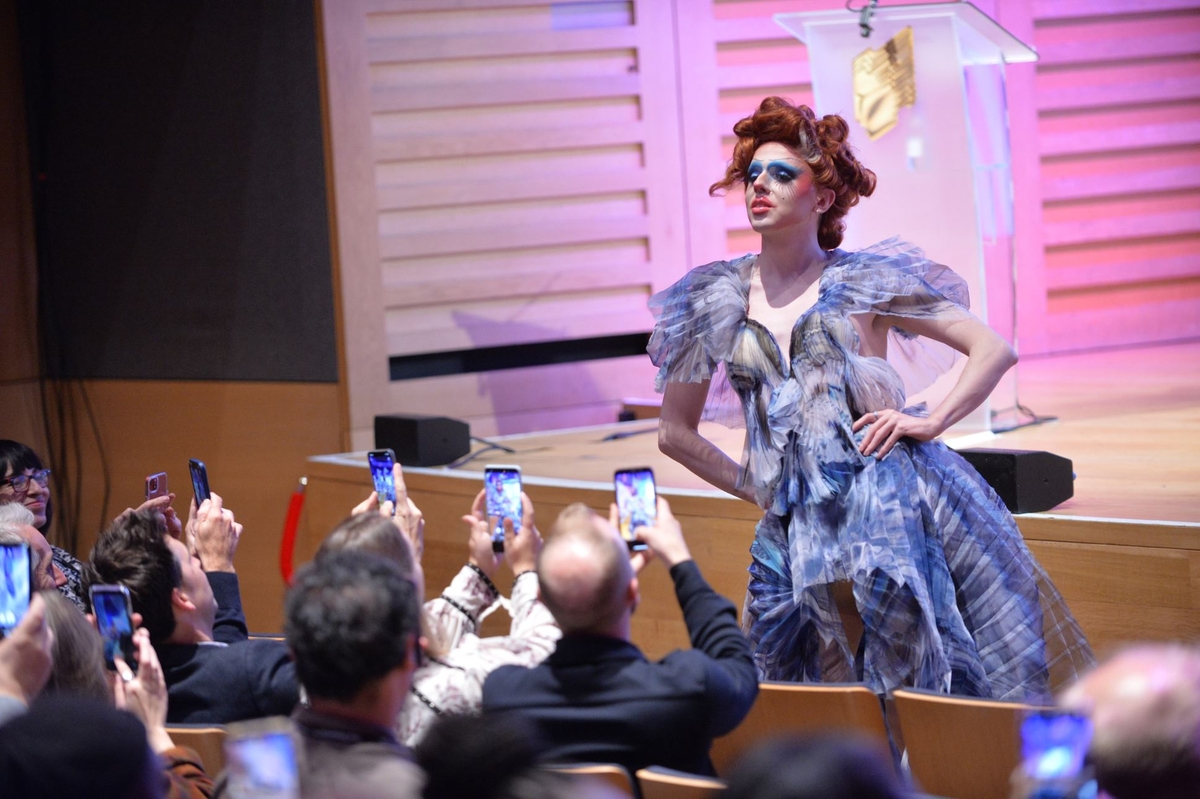
Meta (formerly Facebook) held what it claims was the world’s first metaverse drag show, Queens of the Metaverse, in London last month.
It featured real-life drag queens wearing outfits enhanced by AR and VR. Three high-profile acts – Blu Hydrangea, Tia Kofi and Adam All – took to the runway to show off their metaverse inspired outfits. These were then enhanced and brought to digital life on screen.
One of these dresses was modelled at the RTS London Convention by a drag queen, while its designer, Nwora Emenike, spoke to Marc Cieslak.
Emenike described working on both a physical and digital dress as ‘freeing’. First, he designed the dress using VR software; then he made the physical version.
‘The initial challenge is the barrier to entry, which is having a VR headset, and then you need stable and strong internet – but after, there are literally no barriers,’ he explained. ‘I’m not the best drawer, but it’s a great platform where you can have different creative ideas and create [using a digital] tool.’
‘It is a new world and a boundless space – you can create anything that you want.’
Opportunities for digital fashion design are growing, said Emenike, and these are not just for the designers. Brands, he argued, could diversify: ‘If you’re quite a safe brand and you want to do something cool and young, a bit edgy, this is a new platform. It’s a good space, too, for brands to sponsor creatives and designers.’

